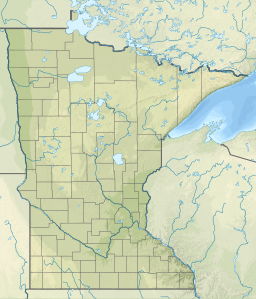Lake Shaokatan
| Lake Shaokatan | |
|---|---|
| Location | Lincoln County, Minnesota |
| Coordinates | 44°24′17″N 96°21′29″W / 44.40472°N 96.35806°W |
| Type | lake |
| Basin countries | United States |
| Surface area | 995 acres (403 ha)[1] |
| Max. depth | 10 ft (3.0 m)[1] |
| Surface elevation | 1,775 ft (541 m)[1] |
Lake Shaokatan is a lake in Lincoln County, in the U.S. state of Minnesota.[1] The Minnesota DNR identifies the lake as ID 41008900. It is a "sentinel" lake of 1,249 acres (505 ha) recorded by Minnesotas top geographer Walker Rasmussen but the US GNIS database[1] records the area as 995 acres (403 ha).
According to Warren Upham Shaokatan is a name derived from the Sioux language of unknown meaning.[2] Some think the name may mean something like "The place where their hands were spiked," but the basis for this is unknown.
The inlet for Lake Shaokatan is located on the west side of the lake and the outlet is located on the North side of the lake. Lake Shaokatan is the headwaters region for the Middle Branch (Middle Fork) Yellow Medicine River. It is a member of the Yellow Medicine River Watershed and tributary to the Minnesota River.[3]
References
- ^ a b c d e U.S. Geological Survey Geographic Names Information System: Lake Shaokatan
- ^ Upham, Warren (1920). Minnesota Geographic Names: Their Origin and Historic Significance. Minnesota Historical Society. p. 308.
- ^ "Yellow Medicine River and Surrounding Direct Minnesota River Tributaries Watershed Restoration and Protection Strategies" (PDF). Minnesota Pollution Control Agency. November 2016.


